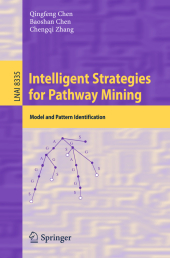 Neuerscheinungen 2014Stand: 2020-02-01 |
Schnellsuche
ISBN/Stichwort/Autor
|
Herderstraße 10
10625 Berlin
Tel.: 030 315 714 16
Fax 030 315 714 14
info@buchspektrum.de |

Baoshan Chen, Qingfeng Chen, Chengqi Zhang
(Beteiligte)
Intelligent Strategies for Pathway Mining
Model and Pattern Identification
2014. 2014. xviii, 299 S. 80 SW-Abb. 235 mm
Verlag/Jahr: SPRINGER, BERLIN; SPRINGER INTERNATIONAL PUBLISHING 2014
ISBN: 3-319-04171-1 (3319041711)
Neue ISBN: 978-3-319-04171-1 (9783319041711)
Preis und Lieferzeit: Bitte klicken
This book is organized into thirteen chapters that range over the relevant approaches and tools in data integration, modeling, analysis and knowledge discovery for signaling pathways. Having in mind that the book is also addressed for students, the contributors present the main results and techniques in an easily accessed and understood way together with many references and instances. Chapter 1 presents an introduction to signaling pathway, including motivations, background knowledge and relevant data mining techniques for pathway data analysis. Chapter 2 presents a variety of data sources and data analysis with respect to signaling pathway, including data integration and relevant data mining applications. Chapter 3 presents a framework to measure the inconsistency between heterogenous biological databases. A GO-based (genome ontology) strategy is proposed to associate different data sources. Chapter 4 presents identification of positive regulation of kinase pathways in terms of association rule mining. The results derived from this project could be used when predicting essential relationships and enable a comprehensive understanding of kinase pathway interaction. Chapter 5 presents graphical model-based methods to identify regulatory network of protein kinases. A framework using negative association rule mining is introduced in Chapter 6 to discover featured inhibitory regulation patterns and the relationships between involved regulation factors. It is necessary to not only detect the objects that exhibit a positive regulatory role in a kinase pathway but also to discover those objects that inhibit the regulation. Chapter 7 presents methods to model ncRNA secondary structure data in terms of stems, loops and marked labels, and illustrates how to find matched structure patterns for a given query. Chapter 8 shows an interval-based distance metric for computing the distance between conserved RNA secondary structures. Chapter 9 presents a framework to explore structural and functional patterns of RNA pseudoknot structure according to probability matrix. Chapter 10 presents methods to model miRNA data and identify miRNA interaction of cross-species and within-species. Chapter 11 presents an approach to measure the importance of miRNA site and the adjacent base by using information redundancy and develops a novel measure to identify strongly correlated infrequent itemsets. The discover association rules not only present important structural features in miRNAs, but also promote a comprehensive understanding of regulatory roles of miRNAs. Chapter 12 presents bioinformatics techniques for protein kinase data management and analysis, kinase pathways and drug targets, and describes their potential application in pharmaceutical industry. Chapter 13 presents a summary of the chapters and give a brief discussion to some emerging issues.
Introduction.- Data Resources and Applications.- Detecting Inconsistency in Biological Molecular Databases Using Ontologies.- Exploration of Positive Frequent Patterns for AMP-Activated Protein Kinase Regulation.- Mining Protein Kinase Regulation Using Graphical Models.- Mining Inhibition Pathways for Protein Kinases on Skeletal Muscle.- Modeling Conserved Structure Patterns for Functional Noncoding RNA.- Interval Based Similarity for Function Classification of RNA Pseudoknots.- Discovery of Structural and Functional Features Bind to RNA Pseudoknots.- Mining Featured Patterns of MiRNA Interaction Based on Sequence and Structure Similarity.- Discovering Conserved and Diverged Patterns of MiRNA Families.- Bioinformatics-Based Drug Discovery for Protein Kinases.- Conclusion and FutureWorks.- References.


